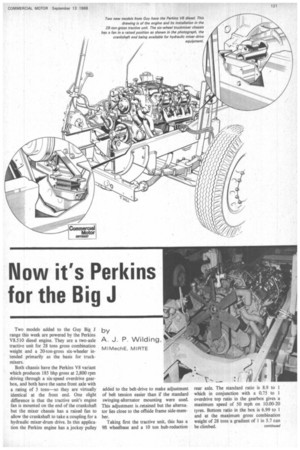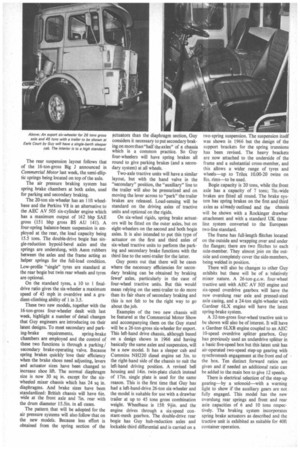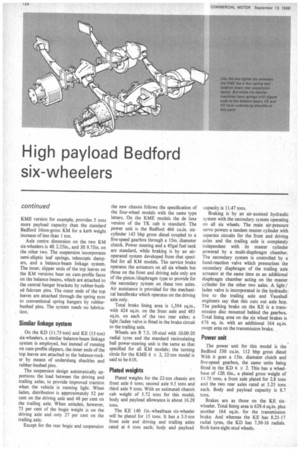Now it's Perkins for the Big J
Page 123

Page 124

Page 125

Page 126

If you've noticed an error in this article please click here to report it so we can fix it.
by A. J. P. Wilding,
M I MechE, MIRTE Two models added to the Guy Big J range this week are powered by the Perkins V8.510 diesel engine. They are a two-axle tractive unit for 28 tons gross combination weight and a 20-ton-gross six-wheeler intended primarily as the basis for truckmixers.
Both chassis have the Perkins V8 variant which produces 185 bhp gross at 2,800 rpm driving through a six-speed overdrive gearbox, and both have the same front axle with a rating of 5 tons—so they are virtually identical at the front end. One slight difference is that the tractive unit's engine Ian is mounted on the end of the crankshaft but the mixer chassis has a raised fan to allow the crankshaft to take a coupling for a hydraulic mixer-drum drive. In this application the Perkins engine has a jockey pulley added to the belt-drive to make adjustment of belt tension easier than if the standard swinging-alternator mounting were used. This adjustment is retained but the alternator lies close to the offside frame side-member.
Taking first the tractive unit, this has a 911 wheelbase and a 10 ton hub-reduction rear axle. The standard ratio is 8.9 to 1 which in conjunction with a 0.75 to I overdrive top ratio in the gearbox gives a maximum speed of 50 mph on 10.00-20 tyres. Bottom ratio in the box is 6.99 to 1 and at the maximum gross combination weight of 28 tons a gradient of 1 in 5.7 can
be climbed. continued
The rear suspension layout follows that of the 16-ton-gross Big J announced in Commercial Motor last week, the semi-elliptic springs being located on top of the axle.
The air pressure braking system has spring brake chambers at both axles, used for parking and secondary braking.
The 20-ton six-wheeler has an 11ft wheelbase and the Perkins V8 is an alternative to the AEC AV 505 six-cylinder engine which has a maximum output of 162 bhp SAE gross (151 bhp gross BS AU 141). A four-spring balance-beam suspension is employed at the rear, the load capacity being 15.5 tons. The double-drive bogie has single-reduction hypoid-bevel axles and the springs are underslung, with Aeon rubbers between the axles and the frame acting as helper springs for the full-load condition. Low-profile "single" tyres are standard at the rear bogie but twin rear wheels and tyres are optional.
On the standard tyres, a 10 to I finaldrive ratio gives the six-wheeler a maximum speed of 45 mph in overdrive and a gradient-climbing ability of 1 in 3.5.
These two new models, together with the 16-ton-gross four-wheeler dealt with last week, highlight a number of detail changes that Guy engineers are introducing on their latest designs. To meet secondary and park ing-brake requirements, spring-brake chambers are employed and the control of these two functions is through a parking! secondary brake-operating valve. Because spring brakes quickly lose their efficiency when the brake shoes need adjusting, levers and actuator sizes have been changed to increase shoe lift. The normal diaphragm size is now 30 sq in. except for the sixwheeled mixer chassis which has 24 sq in. diaphragms. And brake sizes have been standardized: British chassis will have 6in. wide at the front axle and 7in. rear with the drum diameter 15.5in. in all cases.
The pattern that will be adopted for the air pressure systems will also follow that on the new models. Because less effort is obtained from the spring section of the actuators than the diaphragm section, Guy considers it necessary to put secondary braking on more than "half the axles" of a chassis which is a common practice. So Guy four-wheelers will have spring brakes all round to give parking brakes (and a secondary system) at all wheels.
Two-axle tractive units will have a similar layout, but with the hand valve in the "secondary" position, the "auxiliary" line to the trailer will also be pressurized and on moving the lever across to "park" the trailer brakes are released. Load-sensing will be standard on the driving axles of tractive units and optional on the rigids.
On six-wheel rigids, spring brake actuators will be fitted on the outer axles, but on eight-wheelers on the second and both bogie axles. It is also intended to put this type of actuator on the first and third axles of six-wheel tractive units to perform the parking and secondary brake functions with the third line to the semi-trailer for the latter.
Guy ponts out that there will be cases where the necessary efficiencies for secondary braking can be obtained by braking fewer axles, particularly in the case of four-wheel tractive units. But this would mean relying on the semi-trailer to do more than its fair share of secondary braking and this is not felt to be the right way to go about the job.
Examples of the two new chassis will be featured at the Commercial Motor Show and accompanying them on the Guy stand will be a 26-ton-gross six-wheeler for export. This left-hand drive chassis, although based on a design shown in 1966 and having basically the same axles and suspension, will be a new model. It has a sleeper cab and Cummins NH220 diesel engine set 3in. to the right-hand side of the chassis to suit the left-hand driving position. A revised bell housing and 14in. twin-plate clutch instead of 17in. single plate is used for the same reason. This is the first time that Guy has had a left-hand-drive 26-ton six-wheeler and the model is suitable for use with a drawbar trailer at up to 45 tons gross combination weight. Wheelbase is I5ft 9iin. and the engine drives through a six-speed constant-mesh gearbox. The double-drive rear bogie has Guy hub-reduction axles and lockable third differential and is carried on a
two-spring suspension. The suspension itself was shown in 1966 but the design of the support brackets for the spring trunnions has been revised. The heavy brackets are now attached to the underside of the frame and a substantial cross-member, and this allows a wider range of tyres and wheels—up to Trilex 10.00-20 twins on 8in. rims—to be used.
Bogie capacity is 20 tons, while the front axle has a capacity of 7 tons; 7in.-wide brakes are fitted all round. The brake system has spring brakes on the first and third axles as already outlined and the chassis will be shown with a Rockinger drawbar attachment and with a standard UK threeline system converted to the European two-line standard.
The frame has full-length flitches located on the outside and wrapping over and under the flanges; there are two flitches to each side-member. They almost join on the outside and completely cover the side-members, being welded in position.
There will also be changes to other Guy exhibits but these will be of a relatively minor nature. A 26-ton-g.c.w. four-wheel tractive unit with AEC AV 505 engine and six-speed overdrive gearbox will have the new overslung rear axle and pressed-steel axle casing, and a 24-ton eight-wheeler with Gardner 6LX engine will have the latest spring-brake system.
A 32-ton-gross four-wheel tractive unit to be shown will also be of interest. It will have a Gardner 6LXB engine coupled to an AEC 10-speed overdrive splitter gearbox. Guy has previously used an underdrive splitter in a basic five-speed box but this latest unit has air-operated two-speed step-up gearing with synchromesh engagement at the front end of the box. Ten distinct forward ratios are given and if needed an additional ratio can be added to the main box to give 12 speeds.
There is electrical selection of the step-up gearing--by a solonoid—with a warning light to show if the auxiliary gears are not fully engaged. This model has the new overslung rear springs and front and rear axle capacities of 6 and 10 tons respectively. The braking system incorporates spring brake actuators as described and the tractive unit is exhibited as suitable for 40ft container operation. A range of four factory-built Bedford six-wheel chassis /cabs rated from 11.75 to 22 tons gross vehicle weight is to be introduced at the Commercial Motor Show. The two lighter chassis will be basically similar to models already sold through Vauxhall Motors' Special Installations Department and the Earls Court Show marks the productionizing of these models. The two heavier six-wheelers are based on the KM long-wheelbase chassis and will be built on the Bedford production line, while the others will continue to be part line-built and finished in a separate section.
All four models are 6 X 2 chassis featuring four-spring suspension with balance beams between the springs on each side of the chassis. The layout provides that the proportion of weight carried by the driving axle increases as the load on the platform is reduced. This is done by using different rate springs for the driving and trailing axles.
Heaviest of the new models is the KME with a I6ft 7in. wheelbase (centre-line front axle to centre-line bogie) and this can gross 22 tons. It is due to go into production in October at the same time as a 20-ton model also based on the KM chassis but with a wheelbase of 13ft 3in., which results in the lower gross weight. The other two new models are the KD with 12ft 6in. wheelbase and plated for 11.75 tons gross and the KE with 14ft lin. wheelbase and plated for 15 tons gross; these two will be available later.
An important feature of the new Bedfords is that they allow high payloads with greater flexibility in load positioning than a maximum-gross four-wheeler can offer. The KME version for example, provides 5 tons more payload capacity than the standard Bedford 16ton-gross KM for a kerb weight increase of less than 1 ton.
Axle centre dimension on the two KM six-wheelers is 4ft 2.25in., and 311 9.75in. on the other two. The suspension incorporates semi-elliptic leaf springs, telescopic dampers, and a balance-beam linkage system. The inner, slipper ends of the top leaves on the KM versions bear on cam-profile faces on the balance beams, which are attached to the central hanger brackets by rubber-bushed fulcrum pins. The outer ends of the top leaves are attached through the spring eyes to conventional spring hangers by rubberbushed pins. The system needs no lubrication.
Similar linkage system
On the KD (11.75-ton) and KE (15-ton) six-wheelers, a similar balance-beam linkage system is employed, but instead of running on cam-profile slippers, the inner ends of the top leaves are attached to the balance-rocker by means of underslung shackles and rubber-bushed pins.
The suspension design automatically apportions the load between the driving and trailing axles, to provide improved traction when the vehicle is running light. When laden, distribution is approximately 52 per cent on the driving axle and 48 per cent on the trailing axle. When unladen, however, 73 per cent of the bogie weight is on the driving axle and only 27 per cent on the trailing axle.
Except for the rear bogie and suspension the new chassis follows the specification of the four-wheel models with the same type letters. On the KME models the de luxe version of the TK cab is standard. The power unit is the Bedford 466 cu.in. sixcylinder 143 bhp gross diesel coupled to a five-speed gearbox through a 15in. diameter clutch. Power steering and a 45ga1 fuel tank are standard, while braking is by an airoperated system developed from that specified for all KM models. The service brake operates the actuators on all six wheels but those on the front and driving axle only are of the piston /diaphragm type to provide for the secondary system on these two axles. Air assistance is provided for the mechanical handbrake which operates on the driving axle only.
Total brake lining area is 1,394 sq.in., with 424 sq.in. on the front axle and 485 sq.in. on each of the two rear axles; a light /laden valve is fitted in the brake circuit to the trailing axle.
Wheels are B 7.5, 10-stud with 10.00-20 radial tyres and the standard recirculating ball power-steering unit is the same as that specified for all KM models; the turning circle for the KME 6 x 2, 22-ton model is said to be 6111.
Plated weights
Plated weights for the 22-ton chassis are front axle 6 tons; second axle 9.5 tons and third axle 9 tons. With an estimated chassis cab weight of 5.72 tons for this model, body and payload allowance is about 16.28 tons.
The KE 14ft lin.-wheelbase six-wheeler will be plated for 15 tons. It has a 3.5-ton front axle and driving and trailing axles rated at 6 tons each; body and payload capacity is 11.47 tons.
Braking is by an air-assisted hydraulic system with the secondary system operating on all six wheels. The main air-pressure servo powers a tandem master cylinder with separate circuits for the front and driving axles and the trailing axle is completely independent with its master cylinder powered by a multi-diaphragm chamber. The secondary system is controlled by a hand-reaction valve which pressurizes the secondary diaphragm of the trailing axle actuator at the same time as an additional diaphragm chamber acting on the master cylinder for the other two axles. A light / laden valve is incorporated in the hydraulic line to the trailing axle and Vauxhall engineers say that this cuts out axle hop. The parking brake on the KE is a transmission disc mounted behind the gearbox. Total lining area on the six wheel brakes is 676 sq. in. with an additional 164 sq.in. swept area on the transmission brake.
Power unit
The power unit for this model is the Bedford 330 cu.in. 112 bhp gross diesel With it goes a 13in. diameter clutch and five-speed gearbox, the same units being fitted in the KD 6 x 2. This has a wheelbase of 1211 6in., a plated gross weight of 11.75 tons, a front axle plated for 2.8 tons and the two rear axles rated at 5.25 tons each. Body and payload capacity is 8.7 tons.
Brakes are as those on the KE sixwheeler. Total lining area is 629.4 sq.in. plus another 164 sq.in. for the transmission brake. And whereas the KE has 8.25-17 radial tyres, the KD has 7.50-16 radials. Both have eight-stud wheels.




































































































































































































































































